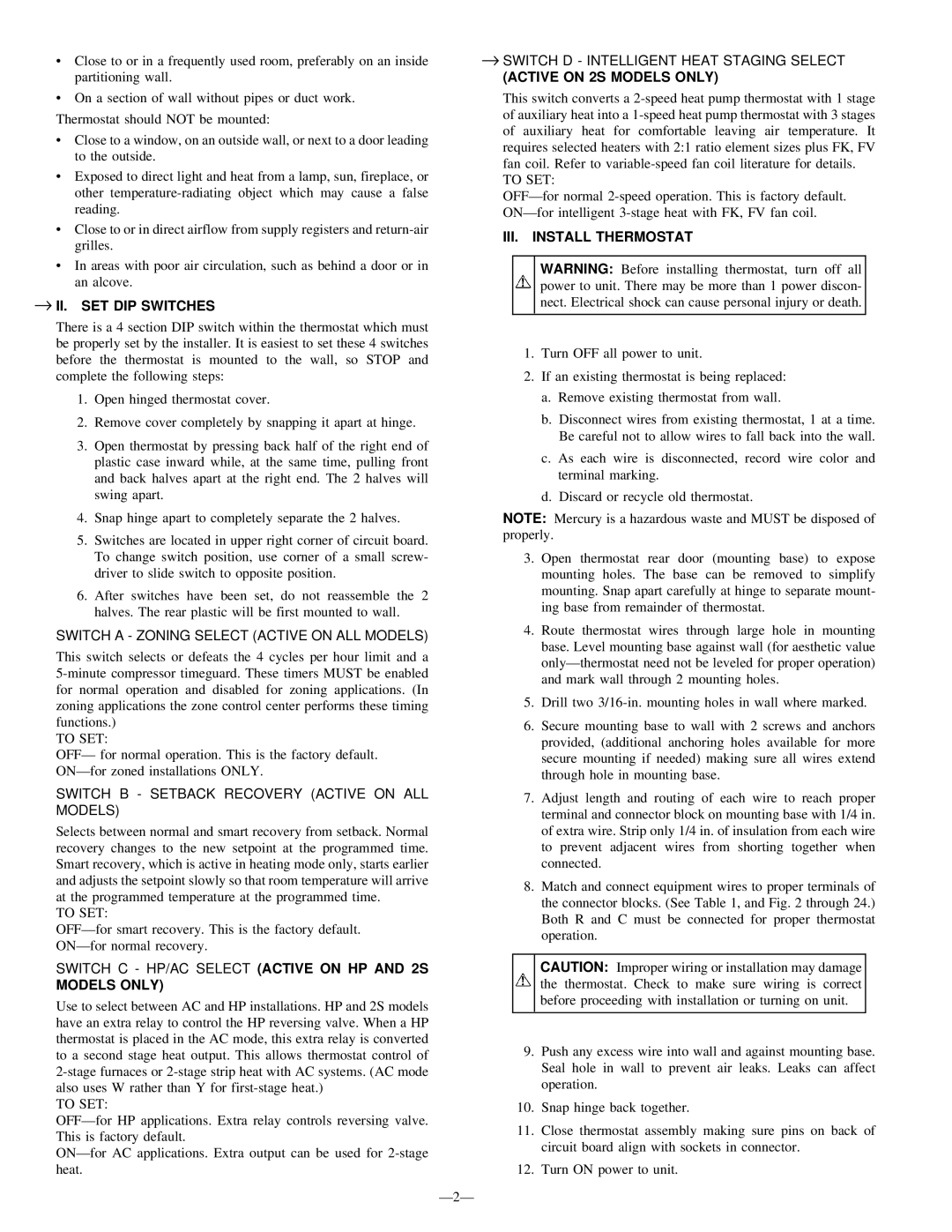
·Close to or in a frequently used room, preferably on an inside partitioning wall.
·On a section of wall without pipes or duct work.
Thermostat should NOT be mounted:
·Close to a window, on an outside wall, or next to a door leading to the outside.
·Exposed to direct light and heat from a lamp, sun, fireplace, or other
·Close to or in direct airflow from supply registers and
·In areas with poor air circulation, such as behind a door or in an alcove.
→II. SET DIP SWITCHES
There is a 4 section DIP switch within the thermostat which must be properly set by the installer. It is easiest to set these 4 switches before the thermostat is mounted to the wall, so STOP and complete the following steps:
1.Open hinged thermostat cover.
2.Remove cover completely by snapping it apart at hinge.
3.Open thermostat by pressing back half of the right end of plastic case inward while, at the same time, pulling front and back halves apart at the right end. The 2 halves will swing apart.
4.Snap hinge apart to completely separate the 2 halves.
5.Switches are located in upper right corner of circuit board. To change switch position, use corner of a small screw- driver to slide switch to opposite position.
6.After switches have been set, do not reassemble the 2 halves. The rear plastic will be first mounted to wall.
SWITCH A - ZONING SELECT (ACTIVE ON ALL MODELS)
This switch selects or defeats the 4 cycles per hour limit and a
TO SET:
OFFÐ for normal operation. This is the factory default. ONÐfor zoned installations ONLY.
SWITCH B - SETBACK RECOVERY (ACTIVE ON ALL MODELS)
Selects between normal and smart recovery from setback. Normal recovery changes to the new setpoint at the programmed time. Smart recovery, which is active in heating mode only, starts earlier and adjusts the setpoint slowly so that room temperature will arrive at the programmed temperature at the programmed time.
TO SET:
OFFÐfor smart recovery. This is the factory default. ONÐfor normal recovery.
SWITCH C - HP/AC SELECT (ACTIVE ON HP AND 2S
MODELS ONLY)
Use to select between AC and HP installations. HP and 2S models have an extra relay to control the HP reversing valve. When a HP thermostat is placed in the AC mode, this extra relay is converted to a second stage heat output. This allows thermostat control of
TO SET:
OFFÐfor HP applications. Extra relay controls reversing valve. This is factory default.
ONÐfor AC applications. Extra output can be used for
→SWITCH D - INTELLIGENT HEAT STAGING SELECT
(ACTIVE ON 2S MODELS ONLY)
This switch converts a
TO SET:
OFFÐfor normal
III. INSTALL THERMOSTAT
WARNING: Before installing thermostat, turn off all power to unit. There may be more than 1 power discon- nect. Electrical shock can cause personal injury or death.
1.Turn OFF all power to unit.
2.If an existing thermostat is being replaced:
a.Remove existing thermostat from wall.
b.Disconnect wires from existing thermostat, 1 at a time. Be careful not to allow wires to fall back into the wall.
c.As each wire is disconnected, record wire color and terminal marking.
d.Discard or recycle old thermostat.
NOTE: Mercury is a hazardous waste and MUST be disposed of properly.
3.Open thermostat rear door (mounting base) to expose mounting holes. The base can be removed to simplify mounting. Snap apart carefully at hinge to separate mount- ing base from remainder of thermostat.
4.Route thermostat wires through large hole in mounting base. Level mounting base against wall (for aesthetic value onlyÐthermostat need not be leveled for proper operation) and mark wall through 2 mounting holes.
5.Drill two
6.Secure mounting base to wall with 2 screws and anchors provided, (additional anchoring holes available for more secure mounting if needed) making sure all wires extend through hole in mounting base.
7.Adjust length and routing of each wire to reach proper terminal and connector block on mounting base with 1/4 in. of extra wire. Strip only 1/4 in. of insulation from each wire to prevent adjacent wires from shorting together when connected.
8.Match and connect equipment wires to proper terminals of the connector blocks. (See Table 1, and Fig. 2 through 24.) Both R and C must be connected for proper thermostat operation.
CAUTION: Improper wiring or installation may damage the thermostat. Check to make sure wiring is correct before proceeding with installation or turning on unit.
9.Push any excess wire into wall and against mounting base. Seal hole in wall to prevent air leaks. Leaks can affect operation.
10.Snap hinge back together.
11.Close thermostat assembly making sure pins on back of circuit board align with sockets in connector.
12.Turn ON power to unit.
Ð2Ð
